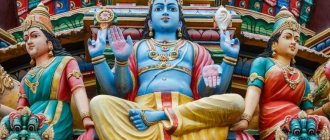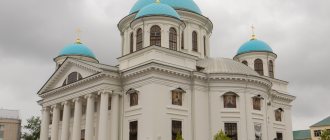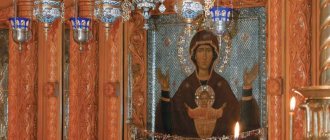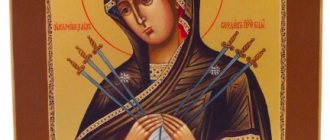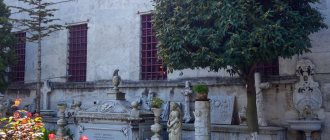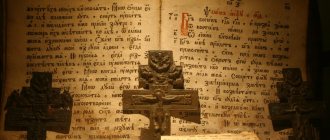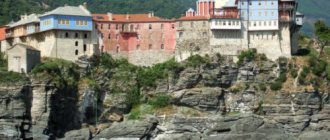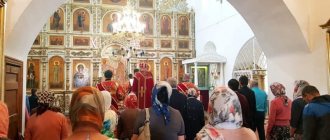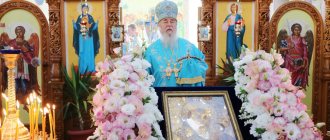Updated: 03/02/2020
Icon painting is a type of artistic art. But, unlike its other types, it carries much more meanings and meanings. The mission of a sacred work is radically different from that of paintings, even if they have spiritual content. Few of the Orthodox icon painters are known; moreover, holy images were often painted collectively: the master painted the face, and the assistants painted everything else. Here are five, perhaps, the most famous icons in the Orthodox world .
Icon of the Vladimir Mother of God
One of the most revered images in Russian Orthodoxy is the Vladimir Icon with the image of the Mother of God. According to legend, it belongs to the brush of the Evangelist Luke. The image, as the same legend says, was painted on a wooden tabletop where the Savior, the Most Pure Virgin and the righteous Joseph gathered for a meal.
The image came to Russia in 1131 - it was sent as a gift to Yuri Dolgoruky. Since then, he has been protecting Rus' from foreigners and performing miracles. Thus, they say that the icon saved the Russian land from Tamerlane, in 1480 - from the destruction of Rus' by the Golden Horde leader Akhmat, and in 1521 it saved Moscow from the defeat of the Kazan Khan Mehmet-Girey.
Dionysius (about 1440 - 1502)
Researchers consider the Moscow icon painter Dionysius to be a successor to the traditions of Andrei Rublev.
An interesting fact: the frescoes of the Ferapontov Monastery, painted by the icon painter, are perfectly preserved and allow art historians to learn as much as possible about the artist’s painting style. This work of the master has never undergone serious restoration, and therefore has been preserved in almost its original form.
Famous works of the icon painter include:
- painting of the Cathedral of the Nativity of the Virgin;
- paintings of the Cathedral of the Nativity of the Virgin Mary at the Ferapontov Monastery;
- "Our Lady Hodegetria";
- "Epiphany";
- "Descent into Hell"
and others.
"Trinity" by Andrei Rublev
In the Tretyakov Hall there is one of the most famous icons of the Orthodox world - “The Trinity”, painted by Andrei Rublev - the master’s most famous work. It was created at the beginning of the 15th century (experts find it difficult to name the exact date) for the majestic white stone Trinity Cathedral.
It was assumed that the icon would stand to the right of the Royal Doors. The image is multifaceted and multi-layered, filled with symbols and meanings. Therefore, a lot of scientific research has been devoted to the plot of this masterpiece.
Alypiy of Pechersk (about 1070 - 1114)
Alypiy Pechersky was a famous icon painter, mosaicist, and jeweler who lived in the 9th century. He also had the status of a reverend saint. He studied icon painting from Greek masters.
Art historians have found chronicle sources, according to which it became known that he was revered in Russia , had the gift of a healer, performed miracles, and the icons painted by him also had miraculous powers.
Unfortunately, the icon painter’s original works have not survived to this day . One of the sources reports that the artist painted a five-figure Deesis and two local icons .
Some researchers also came to the conclusion that the icon painter painted the “Yaroslavl Oranta ,” which was subsequently donated to the Assumption Cathedral, located in Rostov.
Icon of the Kazan Mother of God
The miraculous canonical icon was found in the mid-summer of 1579, a quarter of a century after the conquest of the Kazan Khanate by Ivan the Terrible. Patriarch Hermogenes wrote that on the eve of July 8 - the day the relic was found - a strong fire occurred in Kazan, due to which half the city burned out, including part of the Kremlin. The Tatars gloated - they say that higher powers punished the wicked who encroached on Muslim lands. Sagittarius Daniil Onuchin was going to build a new house on the site of the burnt one, but his ten-year-old daughter Matrona prevented him.
The girl said that the Mother of God appeared to her in a dream and ordered her to find an image at the site of the future construction site. They waved the little girl aside, but she insisted again and again that the fire needed to be dug up.
In the end, they gave in to the girl and began to rake away the ashes and remains of the burnt building. This is how the image of the Kazan Mother of God was found on the ashes. The miraculous icon cured diseases and inspired soldiers; Peter I and Mikhail Kutuzov prayed before it on the eve of great campaigns. At the beginning of the last century, the icon was destroyed, but numerous copies of it were distributed throughout the world. The earliest one can be seen in the hall of the Tretyakov Gallery.
Religion:
1. Vladimir Icon of the Mother of God
According to legend, the Vladimir Icon of the Mother of God was painted by the Evangelist Luke himself. It was brought to Russia at the beginning of the 12th century as a gift to Prince Mstislav. The icon was recognized as miraculous after it three times withdrew the invaders’ troops from Moscow.
Now the icon is in the Church-Museum of St. Nicholas in Tolmachi at the Tretyakov Gallery.
2. Icon "Trinity"
The famous Trinity icon was painted by Andrei Rublev in the 15th century for the iconostasis of the Trinity Cathedral. Over the 600 years of its existence, the icon was renewed five times, but after the restoration in 1919, the author’s layer was again discovered.
Now the icon is kept in the Tretyakov Gallery in Moscow.
3. Kazan Icon of the Mother of God
The Kazan Icon of the Mother of God was found on the ashes in 1579 after the Mother of God appeared three times in a dream to the girl Matrona. Today, the Kazan Icon of the Mother of God is one of the most popular in Russia. It is believed that it was her patronage that helped Pozharsky’s militia expel the Poles from Moscow.
Of the three miraculous lists, only the St. Petersburg one has survived to this day; it is now kept in the Kazan Cathedral in St. Petersburg.
4. Tikhvin Icon of the Mother of God
It is generally accepted that the Tikhvin Icon of the Mother of God was found in Tikhvin in 1383. The icon is revered as miraculous. According to legend, it was her intercession in 1613 that helped save the Tikhvin Mother of God Assumption Monastery from the Swedish invasion.
Now the icon of the Tikhvin Mother of God is in the Tikhvin Dormition Monastery.
5. Smolensk Icon of the Blessed Virgin Mary
The Smolensk Icon of the Blessed Virgin Mary was brought to Russia in the 11th century. She was credited with many miracles, including saving Smolensk from the invasion of Batu Khan in 1239.
There are many copies of the Smolensk icon, but the prototype was lost during the occupation of Smolensk by German troops in 1941.
6. Iveron Icon of the Mother of God
In the 9th century, the Iveron Icon was kept in the house of a pious widow, who saved it from destruction by lowering it into the sea. Two centuries later, the icon appeared to the monks of the Iveron Monastery on Mount Athos.
In the 17th century, a copy of the miraculous icon was brought to Russia. Today you can venerate the image in the Novodevichy Convent.
7. Don Icon of the Mother of God
The Don Icon of the Mother of God is double-sided, with the Dormition of the Mother of God depicted on the reverse. The authorship of the icon is attributed to Theophanes the Greek. According to legend, the Cossacks presented this miraculous icon to Dmitry Donskoy before the Battle of Kulikovo in 1380.
Today, the icon is kept in the Tretyakov Gallery and leaves it every year on September 1 (August 19, old style). On this day, the image is transported to the Donskoy Monastery for the festive service.
8. Icon of the Sign of the Blessed Virgin Mary
The Icon of the Sign of the Blessed Virgin Mary dates back to the 12th century. In 1170, when Andrei Bogolyubsky besieged Veliky Novgorod, during a procession along the walls, the icon was pierced by a random arrow. The icon began to cry, and Bogolyubsky’s troops fled in horror.
The image is still kept in the St. Sophia Cathedral in Veliky Novgorod.
9. Kursk-Root Icon of the Mother of God
The icon was found in the forest near Kursk on the Nativity of the Blessed Virgin Mary in 1295. At the site of the acquired image, a spring immediately began to flow.
According to legend, after the Tatar-Mongol raid the icon was cut in half, but as soon as its parts were combined, it miraculously “grew together.”
In 1920, the Kursk Root Icon of the Mother of God was taken from Russia by Wrangel’s army. Since 1957, it has been kept in the Znamensky Cathedral of the Synod of Bishops in New York.
10. Feodorovskaya Icon of the Mother of God
The exact date of painting of the Theodore Icon of the Mother of God is unknown, but the first mentions date back to the 12th century. The icon is considered miraculous; it was saved from fire several times, and in 1613, nun Martha blessed her son Mikhail Romanov with this icon when he was elected to the kingdom.
You can venerate the miraculous icon at the Epiphany-Anastasia Convent in Kostroma.
11. Pskov-Pechersk Icon “Tenderness”
The “Tenderness” icon is a 1521 copy of the Vladimir Icon of the Mother of God. According to legend, the Pskov-Pechersk Icon protected Pskov from the siege of the Polish King Stephen in 1581.
Now the icon is in the Assumption Cathedral of the Pskov-Pechersk Monastery.
12.Saint Nicholas (Ugresh Icon)
The Ugresh Icon appeared to Dmitry Donskoy on his way to the Kulikovo Field in 1380. Later, a monastery was founded on that site, where the image was kept until the monastery was closed in 1925.
Now the miraculous icon is in the State Tretyakov Gallery in Moscow.
13. Icon “Savior of Eleazar”
The revealed image of the Savior of Eleazar was found in November 1352. The icon was recognized as miraculous, and the tree on which the icon was found was walled up in the vault of the temple built where the icon was found.
Since August 2010, the icon of the Savior of Eleazarovsky has been kept in the Spaso-Eleazarovsky Monastery near Pskov.
14. Icon of St. Nicholas the Wonderworker (Nicholas of Mozhaisk)
The icon was painted in the first half of the 17th century from the famous carved sculpture depicting St. Nicholas the Wonderworker with a sword in his hands. In 1993-1995, the icon was restored, revealing the lower layers of paint.
Now the image is in the Church of the Descent of the Holy Spirit in Mozhaisk.
15. Icon of the Mother of God of the Seven Arrows
The revealed image of the Icon of the Mother of God of the Seven Arrows was found in the bell tower in Vologda. For many years, parishioners walked on it, mistaking it for a floorboard. The image was recognized as miraculous during the cholera epidemic in 1830.
Today, the revealed image has been lost, but one of the famous copies, the myrrh-streaming icon “Seven Arrows,” is located in the Church of the Archangel Michael in Moscow.
16. Icon of the Holy Matrona of Moscow
Matrona of Moscow was canonized only in 1999, but her icon, painted in the 21st century, has already been recognized as miraculous. The list contains a particle of the saint's veil and relics.
You can venerate the shrine in the Intercession Monastery in Moscow.
17. Icon of Blessed Xenia of St. Petersburg
Blessed Xenia of Petersburg was canonized in 1988, but they began to venerate the blessed one during her lifetime.
The most famous image is located in the Smolensk Church in St. Petersburg, where everyone can venerate it.
18. Icon of the Transfiguration of the Lord
The icon of the Transfiguration of the Lord was painted in 1403. For a long time, Theophanes the Greek was considered its author, but recent research has shown that the icon was painted by an unknown icon painter of the same period. The creation of the image is associated with the restoration and reconsecration of the Transfiguration Cathedral in Pereslavl-Zalessky.
Since the 20th century, the famous icon has been kept in the Tretyakov Gallery in Moscow.
19. Icon of St. Spyridon of Trimythous
One of the miraculous images of Spyridon of Trimifuntsky is located in the Church of the Resurrection of the Word on the Assumption Vrazhek. Inside the icon is an ark containing the relics of the saint.
20. Icon of St. Basil in Prayer to Christ The icon was painted at the end of the 16th century for the Cathedral of the Intercession on the Moat, which is better known as St. Basil’s Cathedral.
The icon is still kept in the same place and is one of the oldest images of the temple.
21. Savior Not Made by Hands Simona Ushakova
The icon of the Savior Not Made by Hands was painted by Simon Ushakov in 1658. The icon painter was criticized for the uncharacteristic depiction of the face of Christ, but later it was this image that became the most popular in Russia.
Now the icon is kept in the Tretyakov Gallery in Moscow.
22. Icon of the Savior in the Power of Andrei Rublev
The Icon of the Savior in Power was painted by Andrei Rublev and his apprentices for the iconostasis of the Assumption Cathedral in Vladimir in 1408.
The icon can be seen in the Tretyakov Gallery in Moscow.
23. Icon of Seraphim of Sarov One of the most revered icons of Seraphim of Sarov is kept in the Danilov Monastery in Moscow. The image is an exact copy from the cell icon of Schema Abbess Tamar and contains a rosary, part of the saint’s mantle and part of the stone on which he prayed for a thousand days.
24. Icon of Dionysius, Mother of God Hodegetria (Guide)
The icon of the Mother of God Hodegetria was painted by Dionysius in 1482. For a long time the image was kept in the Ascension Monastery in the Moscow Kremlin, but is now in the State Tretyakov Gallery.
25. Pochaev Icon of the Mother of God
The Pochaev icon was first mentioned in chronicles in 1559, when noblewoman Anna Goiskaya presented the icon to the monks of the Dormition Pochaev Lavra. The icon was recognized as miraculous when its patronage saved the monastery from the Turkish siege on July 20-23, 1675.
The image is still kept in the Assumption Pochaev Lavra in Ukraine.
26. Intercession of Saint Sergius of Radonezh
The most famous and earliest image of Sergius of Radonezh is not an icon, but a cover. It was embroidered in the 1420s, and is now in the sacristy of the Trinity-Sergius Lavra.
27. Icon of the Apostles Peter and Paul
The icon of the Apostles Peter and Paul was painted in Novgorod in the 11th century and, with a high probability, is the oldest Russian work of easel painting. Three times in its history the icon left Novgorod, but always returned back.
Now the image is in the Novgorod Museum-Reserve in Veliky Novgorod.
28. Icon. Spas Golden Robe
The image of the Golden Robe of the Savior was painted in the 11th century especially for Rus'. The icon received its name because of the now lost solid gilded frame.
The icon can be venerated in the Assumption Cathedral in the Moscow Kremlin.
29. Icon. Ustyug Annunciation
The Ustyug Annunciation is one of the few surviving icons of the pre-Mongol period. It was written at the beginning of the 12th century in Veliky Novgorod, and transported to Moscow in the middle of the 16th century.
For the last 85 years, the icon has been kept in the State Tretyakov Gallery.
30. Bogolyubskaya Icon of the Mother of God
The Bogolyubsk Icon of the Mother of God is one of the oldest Russian icons (1155) and is revered as miraculous.
During the restoration of 1946, the icon was severely damaged, but subsequent work was able to partially save the image. In 2009, the image suffered again when it was attacked by a fungus that appeared on the icon due to improper storage. Today, the icon is preserved in the Vladimir-Suzdal Museum in a special room. Scientists fear that the new restoration could completely destroy the image.
Author
Russian Seven
Share
Comment
“Savior Not Made by Hands” by Simon Ushakov
Perhaps the most interesting ancient icon is “The Savior Not Made by Hands”, painted in 1658 in the workshop of Simon Ushakov, a royal icon painter of the 17th century. It is interesting for its non-canonical nature and realism - before this, images were written according to the strictest rules. The face of the Savior on the ubrus looks humane and benevolent, even the eyelashes are carefully painted - this is uncharacteristic of ancient Russian icon painting.
The subject of the icon was a biblical legend. One day the Savior washed his face, dried himself with a towel, and his image remained on the cloth. This became the first image of Jesus. The miraculous face is one of the most sacred and revered in Christianity. And it was precisely this that Simon Ushakov repeatedly reproduced in his creations. The most famous piece of furniture by Ushakov is today carefully preserved in the Tretyakov Gallery.
Fyodor Zubov (about 1647 - 1689)
The artist Fyodor Zubov was the head of the paid icon painters at the Moscow Kremlin. Art historians believe that he painted his works in the Baroque style.
He was the creator of a large number of icons; images from his brush can be seen on the walls of many Russian monasteries.
Interesting fact: the icon painter worked in the capital for more than 40 years; a misfortune in his family in the 1660s pushed him to become a master at the royal court and receive a salary for his work. hunger reigned.
Researchers of his work have come to the conclusion that the main features of his works are:
- calligraphic style;
- the predominance of decorative “patterns”;
- the desire to combine ancient traditions of icon painting and innovative achievements.
His most famous works are:
- “Savior Not Made by Hands”;
- "Saint Nicholas";
- "John the Baptist";
- "Nativity of the Virgin Mary"
and some others.
“Savior in Power” by Rublev
The icon “Savior in Power” by the famous Andrei Rublev is very symbolic. According to the creator's plan, it represents the image of Christ located at the center of the Universe. In fact, this is a visual diagram of the Christian world order with all its attributes.
The “Savior in Power” icon is the most important relic in Orthodoxy, and therefore it is always placed in the center of the temple iconostasis, above the Royal Doors. The image by Andrei Rublev is today in the Tretyakov Gallery, in a glass sarcophagus, where special conditions have been created for its storage.
Prokhor "from Gorodets" (15th century)
Researchers assumed that the icon painter was the teacher of Andrei Rublev. information about the life and works of Prokhor “from Gorodets” has survived to this day. Those preserved in the Trinity Chronicle report that he, together with other famous icon painters, painted the Annunciation Cathedral of the Moscow Kremlin.
Experts suggest that Prokhor was much older and more experienced than other icon painters working with him; the chronicles always spoke of him as an “old man.”
Art historians attribute the following works to his brush:
- "The Raising of Lazarus";
- "Ascension";
- "The Last Supper";
- "Position in the coffin";
- "Assumption";
- "Crucifixion";
- "The Descent of the Holy Spirit";
- "Descent into Hell"
For reference: all the works listed above are characterized by the same writing features, that is, the author, when creating them, used the technique of applying rich highlights and sharp highlights. Also, the figures of saints in these images are similar; they have small hands and pointed noses.
Art historians believe that his acquaintance with the works of other Moscow masters, for example, Goitan, Ivan and some others, left an imprint on the icon painter’s work.
